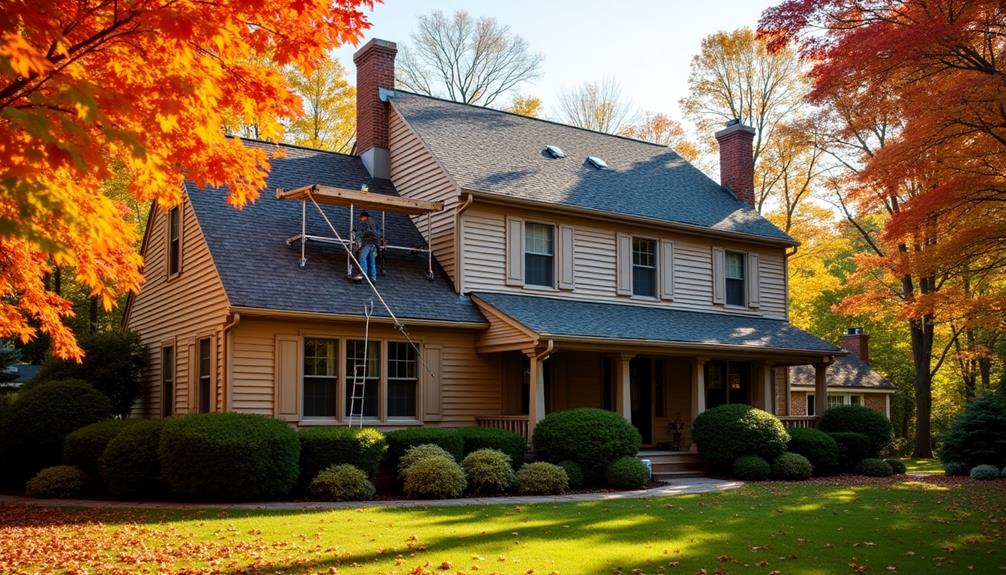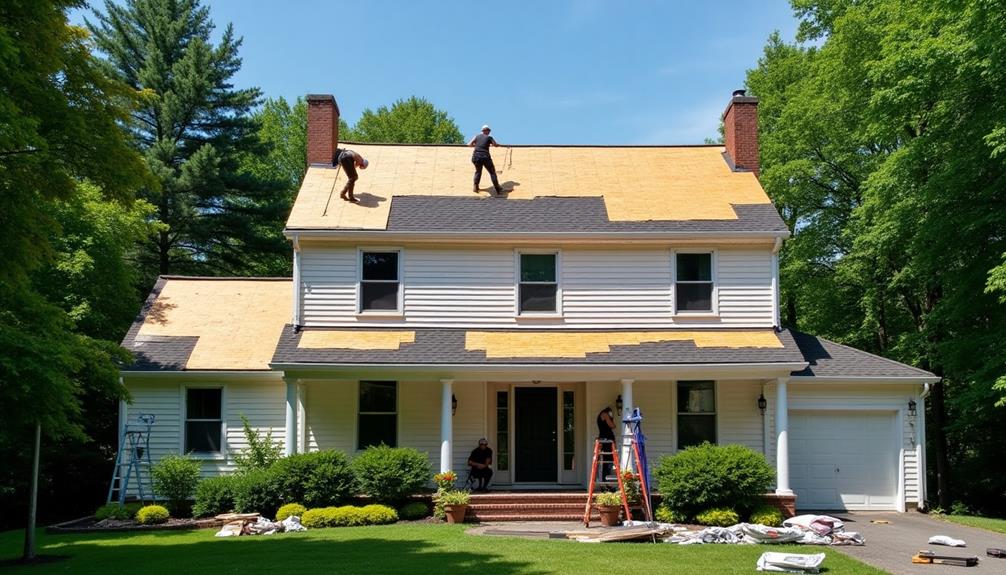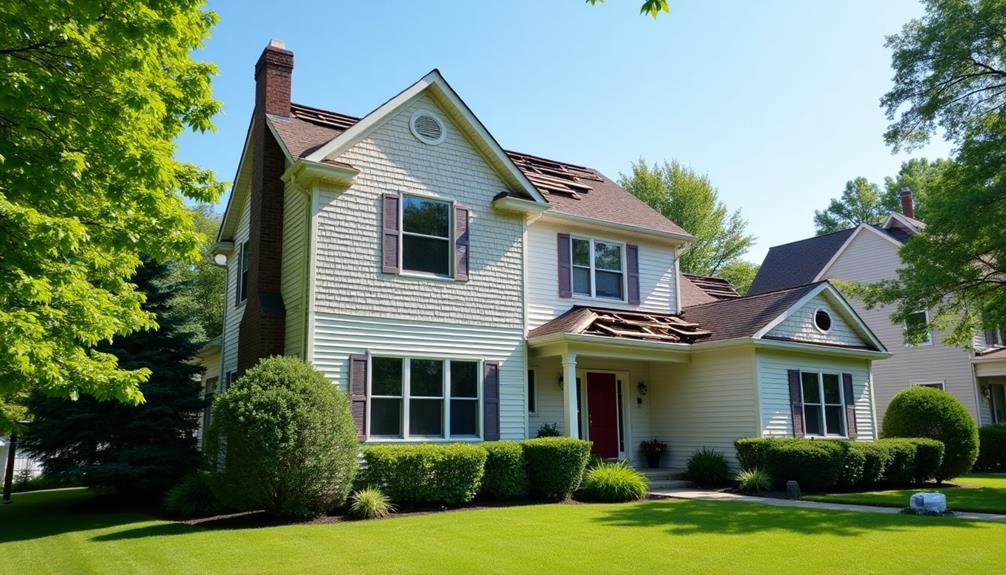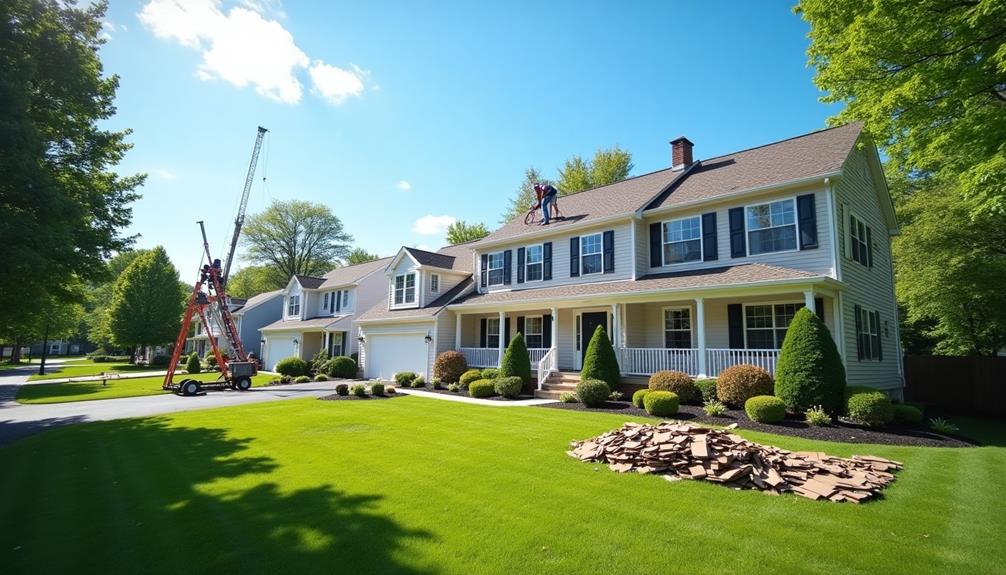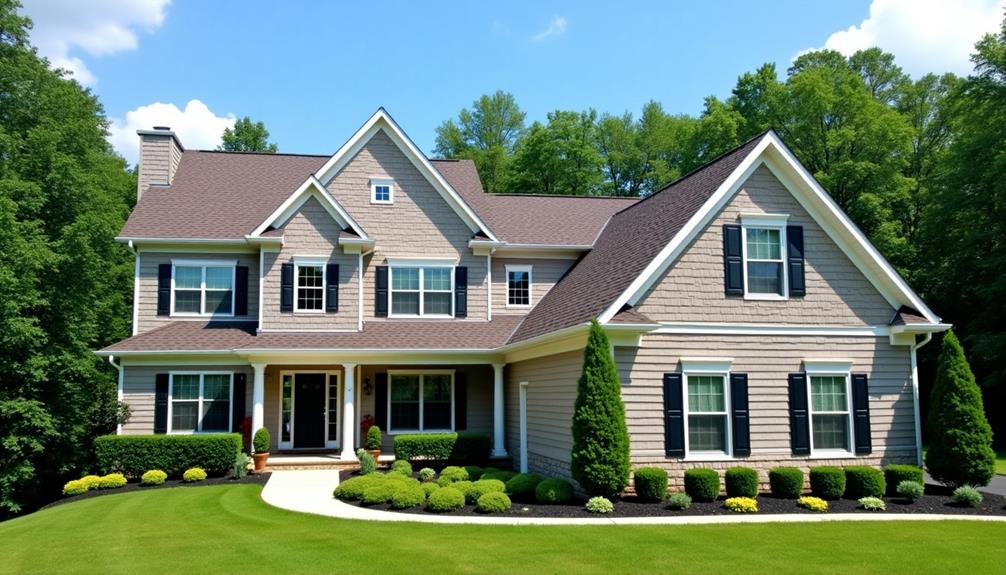Transforming your yard into a serene evening oasis is like painting a masterpiece under the stars. You might be wondering how simple landscape lighting can elevate your outdoor space, enhancing both safety and aesthetics. Choosing the right fixtures and planning your layout are crucial steps that can make a significant difference. As you gather your tools and consider installation options, you'll find that the process is more straightforward than you think. What key elements should you focus on to achieve that perfect glow?
Benefits of Landscape Lighting
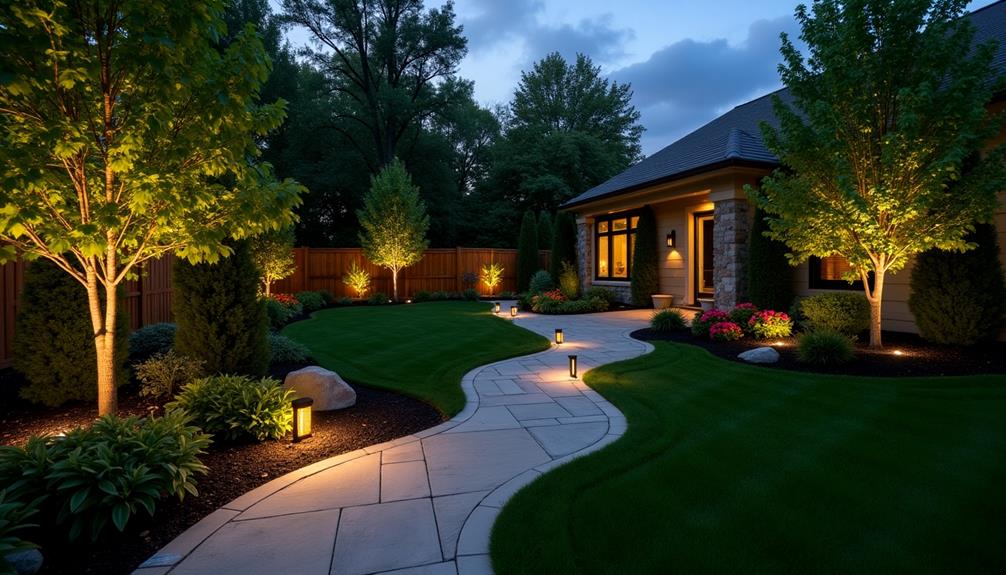
When you think about upgrading your outdoor space, landscape lighting should be at the top of your list. Not only does it enhance the aesthetic appeal of your property, but it also significantly increases safety.
By improving nighttime visibility, you reduce the risk of accidents for family and guests alike. Thoughtfully placed lights can highlight landscape features, drawing attention to beautiful gardens, pathways, and architectural elements.
Another key benefit is energy efficiency. With modern LED options, you can enjoy stunning outdoor ambiance without racking up energy bills. These lights come in various designs, giving you the design versatility to match your personal style and landscape.
Investing in landscape lighting can also elevate your property value. A well-lit yard creates a welcoming atmosphere, making your home more attractive to potential buyers.
Plus, it extends the usability of your outdoor spaces into the evening hours, encouraging gatherings and relaxation under the stars.
Choosing the Right Fixtures
Selecting the right fixtures is key to maximizing the benefits of landscape lighting. You'll want to consider various fixture styles to suit your home's aesthetic and functional needs. For instance, path lights can guide guests safely along walkways, while spotlights highlight architectural features or plants. You might also explore wall-mounted fixtures for added elegance and security.
Energy efficiency should be at the forefront of your decision-making process. Opting for LED fixtures not only reduces your energy consumption but also lowers your electricity bills in the long run. These lights last longer than traditional bulbs, meaning you won't have to replace them as often, saving you both time and money.
When browsing fixture styles, think about the brightness and color temperature that'll best enhance your outdoor space. Warm white lights often create a cozy ambiance, while cooler tones can lend a modern feel.
Remember to check the IP rating of the fixtures, ensuring they're suitable for outdoor conditions. Ultimately, the right combination of style and energy efficiency will create an inviting atmosphere and elevate your landscape's beauty, all while being mindful of your environmental impact.
Planning Your Layout

Before you start installing your landscape lighting, you need to assess your space to understand its features and limitations.
Next, determine your lighting goals to create the perfect ambiance or highlight specific areas.
Assess Your Space
Assessing your space is crucial for planning an effective landscape lighting layout. Begin with a thorough landscape assessment to identify key features in your yard, like trees, pathways, and garden beds. Take note of elements that you want to highlight and those you want to downplay. This step will help you visualize how lighting can enhance your outdoor aesthetics.
Walk around your property during the day and again at night. Pay attention to areas that feel dark or uninviting after sunset. These spots might need additional illumination to create a warm, welcoming atmosphere.
Consider the overall flow of your outdoor space; think about how light can guide guests along pathways or accentuate focal points.
Make a rough sketch of your layout, noting where you'd like to place lights. Remember to consider the intensity and color of the lighting, as these factors can dramatically affect your outdoor aesthetics.
Determine Lighting Goals
Once you've evaluated your space, it's time to determine your lighting goals. Start by considering the lighting aesthetics you want to achieve. Do you prefer a warm, inviting atmosphere or a more modern, sleek look?
Think about how different lighting styles can enhance your landscape while complementing your home's architecture.
Next, assess the areas that need illumination. Are you looking to highlight specific features like trees or pathways, or do you want to create a general ambiance throughout your yard?
Identifying these focal points will help you plan effectively.
Don't forget about energy efficiency. Opt for LED lights, as they consume less power and last longer than traditional bulbs.
This not only helps in reducing your energy bills but also minimizes your environmental impact.
Choose Fixture Types
Choosing the right fixture types is crucial for achieving your landscape lighting goals. Start by considering fixture styles that complement your home and landscape. From sleek modern designs to rustic lanterns, the style can set the mood and enhance your outdoor space's aesthetics.
Think about how each style will look during the day and night to ensure a cohesive appearance.
Next, evaluate fixture materials. You'll find options like aluminum, brass, and plastic, each with its benefits.
Aluminum is lightweight and resistant to rust, making it a popular choice for many homeowners. Brass, while heavier, offers durability and a timeless appeal as it ages beautifully.
Plastic fixtures can be budget-friendly but may not withstand harsh weather conditions as well as metal options.
Gathering Necessary Tools
Before you dive into installing landscape lighting, it's crucial to gather the necessary tools. You'll need a few essential tool types to make the job easier and ensure a successful installation.
Start with a shovel for digging holes for your fixtures. A power drill will help you secure the lights in place, while a wire stripper is necessary for preparing your electrical connections.
Don't forget to have a level on hand to ensure your lights are straight and an extension cord to power your lights during installation. Additionally, a measuring tape will help you space the fixtures evenly.
It's also important to consider safety precautions. Make sure you have safety goggles to protect your eyes when drilling. Gloves are a good idea too, as they'll protect your hands while handling tools and materials.
If you're working with electricity, a voltage tester is vital to ensure the circuit is safe before you begin. By gathering these tools and taking safety precautions, you'll set yourself up for a smoother installation process.
Once you've got everything you need, you'll be ready to light up your landscape beautifully!
Installation Steps
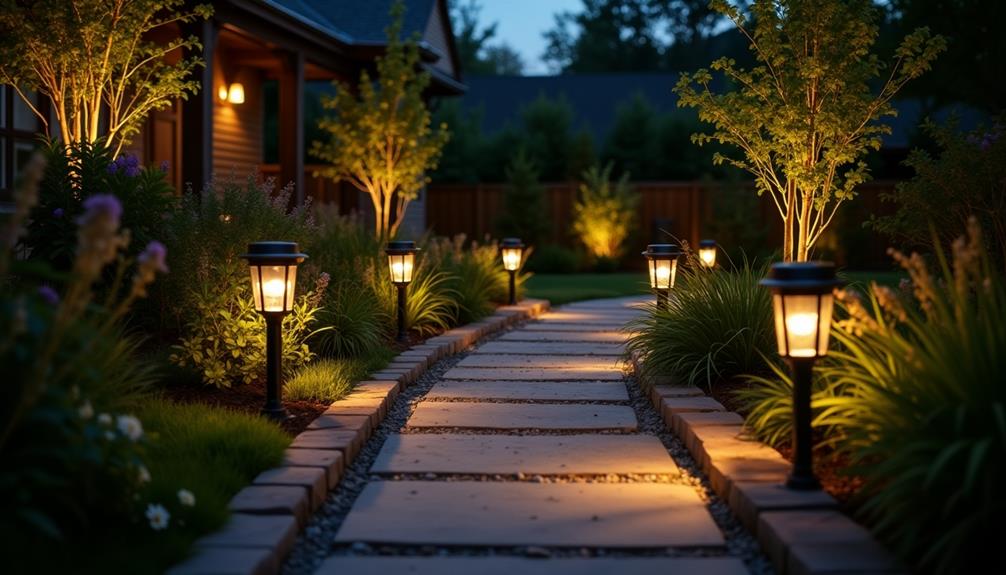
With your tools gathered and safety measures in place, you're ready to begin the installation process for your landscape lighting.
Start by marking the locations where you'll place the lights. This helps ensure even spacing and optimal illumination. Use a measuring tape to maintain uniform distances between fixtures.
Next, dig small holes for each light, making sure they're deep enough to secure the fixtures firmly. If you're using low-voltage lights, follow the specific installation techniques outlined in the manufacturer's instructions.
Once your holes are ready, insert the fixtures and adjust their angles, so they highlight your desired features.
As you're working, remember to wear gloves and safety goggles to protect yourself from any sharp tools or debris.
After positioning the lights, check for any potential hazards, like tree roots or underground lines. It's crucial to avoid damaging these as you work.
Wiring and Power Options
Understanding wiring and power options is essential for a successful landscape lighting installation. You've got two main choices: low voltage systems and solar options.
Low voltage systems are popular because they're safe and energy-efficient. Typically, you'll use a transformer to convert standard voltage to low voltage, allowing you to run wires underground to your lights. This setup minimizes the risk of electric shock and helps you save on electricity costs.
On the other hand, solar options offer a more eco-friendly approach. These lights rely on solar panels to charge during the day, powering your lights at night. Installation is simple since you don't need to dig trenches for wiring.
However, keep in mind that solar lights may not be as bright as low voltage systems, and their performance can be affected by weather conditions and shading.
Ultimately, your choice will depend on your specific needs, budget, and the layout of your landscape. Consider how much light you want and where your power sources are located.
With the right wiring and power options, you can create a stunning outdoor space that enhances your home's beauty and safety.
Maintenance Tips
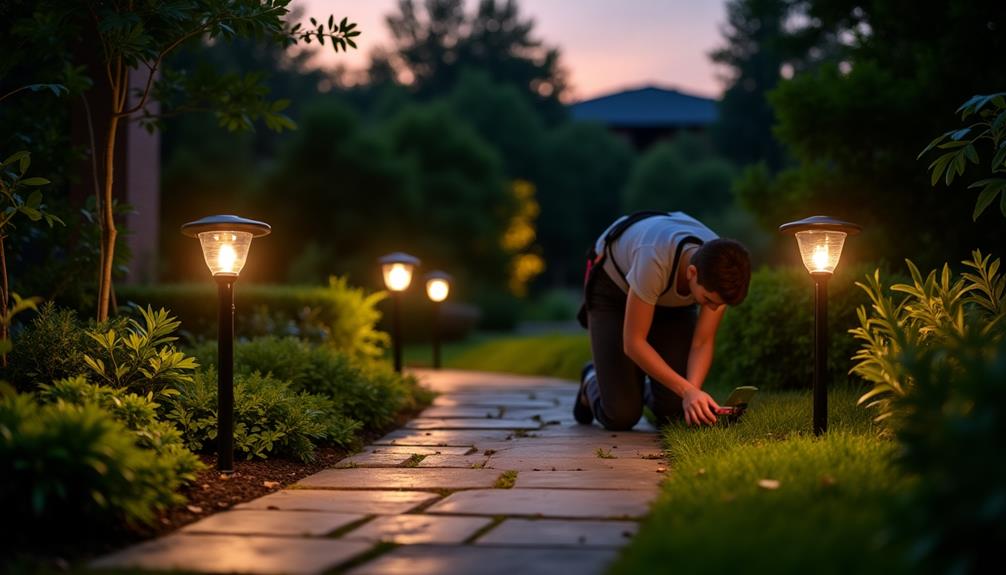
To keep your landscape lighting in top shape, you'll want to replace bulbs regularly and clean the fixtures frequently.
This simple maintenance routine can enhance the brightness and longevity of your lights.
Regular Bulb Replacement
Regularly replacing bulbs in your landscape lighting system is essential for maintaining an inviting outdoor space. Over time, even the best bulbs lose their brightness and efficiency. By staying on top of bulb replacement, you ensure your garden or patio remains well-lit and welcoming.
When choosing bulb types, consider energy-efficient options like LED or CFL bulbs. These not only consume less electricity but also last longer than traditional incandescent bulbs, making them a smart choice for your outdoor lighting.
Regularly check your bulbs for signs of dimness or flickering, as these can indicate it's time for a change. To simplify your maintenance routine, create a schedule for checking and replacing your bulbs, perhaps every six months or at the start of each season.
This way, you can enjoy your beautiful landscape without interruptions caused by burned-out bulbs. Additionally, keep a few spare bulbs on hand to make replacements quick and easy.
Cleaning Fixtures Frequently
Consistently cleaning your landscape lighting fixtures is key to keeping them in top shape. Dust, dirt, and grime can build up over time, reducing the brightness of your lights and impacting their longevity.
Start by identifying your fixture materials; whether they're metal, plastic, or glass, each requires different cleaning techniques.
For metal fixtures, use a soft cloth or sponge with a mild soap solution to avoid scratching the surface. Rinse thoroughly with water to prevent soap residue from forming.
If your fixtures are plastic, a simple mixture of vinegar and water can effectively remove stains and restore clarity without causing damage.
For glass fixtures, use a glass cleaner or a DIY solution of equal parts vinegar and water to give them a streak-free shine.
Make it a habit to clean your fixtures every few months or after heavy storms. Regular maintenance isn't just about aesthetics; it also helps prevent rust or corrosion and keeps your lighting system functioning optimally.
Creative Lighting Ideas
When it comes to enhancing your outdoor space, five creative lighting ideas can transform your landscape into a captivating evening retreat.
First, consider using string lights to create a whimsical atmosphere. Hang them across patios, trees, or fences for warm ambient effects that invite relaxation.
Next, use pathway lights to guide guests safely while adding visual interest.
Third, think about incorporating spotlights to highlight specific features, like a beautiful tree or water fountain. This draws attention and creates dramatic shadows that change the mood.
Fourth, for seasonal themes, you can switch out colored bulbs or use themed decorations for holidays, making your space feel festive year-round.
Lastly, experiment with lanterns. Place them on tabletops or hang them from hooks for a cozy charm. You can even use solar lanterns for energy efficiency.
By integrating these creative lighting ideas, you'll not only enhance your landscape but also create a welcoming ambiance perfect for gatherings or quiet evenings under the stars.
With a little imagination, your outdoor space can become a stunning showcase every night.


